This teaching resource aims to raise awareness of the impacts and causes of the First World War. It is focused on Canterbury and Christchurch’s involvement with the war from 1914-1919 and highlights some of the resources available through Christchurch City Libraries. This pack has been designed to be used with Years 7-10 students with information that could easily be adapted for older students.
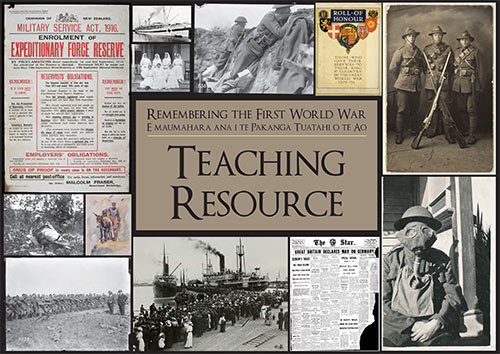
Download the Remembering the First World War Teaching Resource [35 MB PDF]
The resource contains links to booklists accessed through Christchurch City libraries online catalogue. There are also links to library eResources; to access these you will need a library card and password / PIN.
The New Zealand Curriculum
This resource is aligned with the visions and principles of the New Zealand curriculum, and the suggested activities encourage students to be connected and actively involved learners. The resource content reflects the principles of the Treaty of Waitangi and Cultural Diversity. Whilst the resource is primarily focused on the specific learning areas of Social Sciences, English, and the Arts, there are links across many aspects of the curriculum. The variety of activities included are designed to allow opportunities for all of the key competencies and values to be met.
Thanks to Lottery Grants Board for funding this resource
Special thanks to Barry O’Sullivan
Christchurch City Council, Christchurch City Libraries, WW100, Canterbury100, Lottery Grants
Contents
- The Road to War
- The Front Line
- Canterbury Soldiers
- Māori Involvement
- Pacifica Involvement
- Military Hospitals / Nurses
- Animals at War
- Life at Home
- Conscription and Conscientious Objectors
- Communication and Propaganda
- The End of the War
- Remembrance
- Influenza Pandemic
- General Library Resources
- Other Useful Resources
- WW1 Teaching Resource downloads
- Glossary
Resources
The Road to War
- First World War - the road to war booklist
-
First World War
Overview and introduction from N.Z. History -
Origins of the First World War
Overview and detailed story. Origins of the war, URL: https://nzhistory.govt.nz/war/first-world-war-overview/origins, (Manatū Taonga — Ministry for Culture and Heritage), updated 17-May-2017 -
New Zealand First World War History
Resource list of digitised materials from the New Zealand Electronic Text Centre - Papers Past
The Front Line
- First World War - the front line booklist
-
First World War in maps
N.Z. History -
The Western Front
Overview of some of the battles of the western front from N.Z. History -
The Gallipoli Campaign – detailed overview from N.Z. History
URL: https://nzhistory.govt.nz/war/the-gallipoli-campaign/introduction, (Manatū Taonga — Ministry for Culture and Heritage), updated 26-Apr-2023 -
Passchendaele in the Context of the First World War
Resource provided by the Passchendaele Society
Canterbury Soldiers
- First World War - Canterbury Soldiers booklist
-
Cecil Malthus
Collection of his letters and documents from April 1914 to his discharge in April 1917. The letters follow Malthus’ progress from training in New Zealand to his experiences throughout the war, including his time in Egypt preparing for Gallipoli, and his time in France. Malthus was injured in September 1916 and returned to New Zealand in March 1917. -
Herbert Harold Stephens, of Sydenham, Christchurch – war diary
Covers the period from August 13, 1915 to November 16, 1916. -
William Brown
Served with the New Zealand Expeditionary Force, probably in Turkey. He was wounded in the hip and sent to a military hospital in Malta, and then on to England. Letters and postcards are addressed to Jeff Box, a child in Ashburton. - Memorabilia from Oswald Norris
-
Henry Nicholas VC
URL: https://nzhistory.govt.nz/media/photo/henry-nicholas-vc, (Manatū Taonga — Ministry for Culture and Heritage), updated 15-Jun-2017 -
Henry James Nicholas
First soldier from the Canterbury Regiment to be awarded the Victoria Cross. -
Canterbury Mounted Rifles Regiment timeline 1914 – 1919
URL: https://nzhistory.govt.nz/war/canterbury-mounted-rifles, (Manatū Taonga — Ministry for Culture and Heritage), updated 30-Oct-2017 -
Canterbury Mounted Rifles
Concise overview of regiment. - Digital N.Z. collection of images of the Canterbury Mounted Rifles.
-
Cenotaph Database from Auckland War Memorial Museum
Search for First World War service personnel. -
Collections Search - Archives New Zealand
Documentation of Government records, including First World War service records.
Māori Involvement
-
Māori and the First World War
URL: https://nzhistory.govt.nz/war/maori-in-first-world-war/introduction, (Manatū Taonga — Ministry for Culture and Heritage), updated 26-Mar-2019 -
Māori units of the NZEF
URL: https://nzhistory.govt.nz/war/maori-units-nzef, (Manatū Taonga — Ministry for Culture and Heritage), updated 26-Mar-2019 - ‘The Māoris in the Great War’ digitised book from New Zealand Electronic Text Collection, 1926.
- Recruitment waiata and links to other Māori war songs
- ANZAC - Māori in the Great Wars reading list
Pacifica Involvement
- First World War - Pacifica Involvement booklist
-
Pacific Islanders in the NZEF
URL: https://nzhistory.govt.nz/war/pacific-islanders-nzef, (Manatū Taonga — Ministry for Culture and Heritage), updated 9-Jun-2023 -
Capture of German Samoa
URL: https://nzhistory.govt.nz/war/capture-of-samoa, (Manatū Taonga — Ministry for Culture and Heritage), updated 13-Apr-2015 -
The rise of the Mau movement in Samoa
URL: https://nzhistory.govt.nz/politics/samoa/rise-of-mau, (Manatū Taonga — Ministry for Culture and Heritage), updated 2-Sep-2014 - Jon Fraenkel, 'Pacific Islands and New Zealand - Samoa', Te Ara - the Encyclopedia of New Zealand, http://www.TeAra.govt.nz/en/pacific-islands-and-new-zealand/page-4 (accessed 11 April 2025)
-
Pacific Islanders in the NZER – Roll of Honour
Roll of Honour, URL: https://nzhistory.govt.nz/war/pacific-islanders-nzef/roll-of-honour, (Manatū Taonga — Ministry for Culture and Heritage), updated 5-Aug-2021
Military Hospitals/Nurses
- First World War - Nurses booklist
-
The Long, Long Trail
Provides information about base hospitals in France and Flanders. -
Helping the Wounded in Belgium
Details on stretcher bearers, nurses and victims of gas. Medical Units of the NZEF, URL: https://nzhistory.govt.nz/war/medical-units, (Manatū Taonga — Ministry for Culture and Heritage), updated 22-Mar-2017 -
New Zealand Army Nurses
Chapter 5 from digitised book ‘The War Effort of New Zealand’, 1923. -
Merchant Marines in the War
About the role of seafarers in the war, including hospital ships. URL: https://nzhistory.govt.nz/war/merchant-marine, (Manatū Taonga — Ministry for Culture and Heritage), updated 16-Oct-2014 -
Hospital Ships
URL: https://nzhistory.govt.nz/war/first-world-war-hospital-ships, (Manatū Taonga — Ministry for Culture and Heritage), updated 3-May-2017 -
Hospital Ships
Chapter 7 from digitised book ‘The War Effort of New Zealand’, 1923
Animals in the War
- First World War - Animals in the war booklist
-
NZ’s First World War horse
URL: https://nzhistory.govt.nz/war/nz-first-world-war-horses, (Manatū Taonga — Ministry for Culture and Heritage), updated 8-Nov-2016 -
New Zealand Veterinary Corps
Chapter 9 from digitised book ‘The War Effort of New Zealand, 1923.
Life at Home
- First World War - Life at home booklist
-
Christchurch Chronology
A timeline of Christchurch events in chronological order from pre-European times to 1989. - Map of Christchurch 1912
- PapersPast
-
The Home Front
NZ History -
Children, Schools and the First World War
URL: https://nzhistory.govt.nz/war/children-and-first-world-war, (Manatū Taonga — Ministry for Culture and Heritage), updated 22-Dec-2014 - Online catalogue of the School Journal and other resources (subscription required)
- Links to information and photographs in our collections about the places and landmarks of Christchurch
- Events in Canterbury and the world during 1914 to 1919.
Conscription and Conscientious Objectors
- First World War - Conscription and Conscientious Objectors booklist
- Leaflet Advertising a Public Meeting in the Choral Hall, Latimer Square, Anti-Conscription Campaign Committee, Canterbury (N.Z.)
- Overview of Conscientious Objection
-
Conscientious objection and dissent in the First World War
URL: https://nzhistory.govt.nz/war/first-world-war/conscientious-objection, (Manatū Taonga — Ministry for Culture and Heritage), updated 17-Apr-2024 -
Conscription, Conscientious Objection and Pacifism from Te Ara, The Encyclopedia of New Zealand
Mark Derby, 'Conscription, conscientious objection and pacifism - Conscription', Te Ara - the Encyclopedia of New Zealand, http://www.TeAra.govt.nz/en/conscription-conscientious-objection-and-pacifism/page-1 (accessed 11 April 2025) -
First World War census and conscription
URL: https://nzhistory.govt.nz/media/photo/first-world-war-census-and-conscription, (Manatū Taonga — Ministry for Culture and Heritage), updated 17-May-2017 - David Grant. 'Baxter, Archibald McColl Learmond', Dictionary of New Zealand Biography, first published in 1996, updated June, 2015. Te Ara - the Encyclopedia of New Zealand, https://teara.govt.nz/en/biographies/3b19/baxter-archibald-mccoll-learmond (accessed 11 April 2025)
Communication and Propaganda
- First World War - Communication and Propaganda booklist
- New Zealand Newspapers - PapersPast
- British Newspapers - Times Archive, Guardian & Observer
-
National Collection of War Art
Includes portraits, battle scenes, landscapes and abstract works, depicting the men and women who served New Zealand -
First World War art
URL: https://nzhistory.govt.nz/war/first-world-war-art, (Manatū Taonga — Ministry for Culture and Heritage), updated 5-Sep-2014 - World War I Posters: The Graphic Art of Propaganda
-
Mass politics and the Western Front
An article from BBC History website
The End of the War
- First World War - The End of the War booklist
-
City of Christchurch, N.Z. : peace celebrations
Programme of Christchurch peace celebrations, held on 19-21 July 1919 to mark the end of World War I. -
Armistice Day
Overview of Armistice and useful information about New Zealand in 1918. URL: https://nzhistory.govt.nz/war/armistice-day, (Manatū Taonga — Ministry for Culture and Heritage), updated 26-Apr-2023 -
Details of the Treaty of Versailles
Information including video clips from the BBC study guides -
Impact of the Treaty of Versailles
Information from the United States Holocaust Memorial Museum - A personal account of an American soldier at the front on 11th November 1918
Remembrance
- First World War - Remembrance booklist
-
War and Remembrance activities
URL: https://nzhistory.govt.nz/te-akomanga/war-and-remembrance, (Manatū Taonga — Ministry for Culture and Heritage), updated 6-Aug-2024 -
Anzac Day Te Rā o Ngā Hōia
Information on history and ceremoies for Anzac Day fromManatū Taonga — Ministry for Culture and Heritage - Anzac Day and Gallipoli
- Information and links about the Bridge of Remembrance
- Interpreting First World War memorials
- URL: https://nzhistory.govt.nz/war/interpreting-first-world-war-memorials, (Manatū Taonga — Ministry for Culture and Heritage), updated 27-May-2024
- Commonwealth War Graves Commission
Influenza Pandemic
- First World War - Influenza Pandemic booklist
- Opposing Viewpoint in Context eResource
- Christchurch specific information about the Influenza Pandemic
- Nationwide information about the Influenza Pandemic
-
The 1918 flu pandemic
URL: https://nzhistory.govt.nz/culture/influenza-pandemic-1918, (Manatū Taonga — Ministry for Culture and Heritage), updated 29-Nov-2024
General Library Resources
- Digitised local First World War resources from Christchurch City Libraries
-
Christchurch City Libraries resource list
Covering sources of information on the men and women who served in New Zealand forces during the First World War - First World War Fiction booklist
- First World War Picture Books
eResources with useful First World War content
- Britannica Library Teens
- World Book Discover
- The Times Digital Archive
- Papers Past
- History Reference Source
Other Useful Resources
- Official website for New Zealand’s First World War centenary projects and activities
- First World War educational resources and activities
-
Any Questions
Online school homework help for New Zealand school students - The First World War collection from NZ On Screen
- National Library research guide for the First World War
-
Digital NZ
New Zealand items from the digital stores of libraries, museums, archives, communities, and government - NZ History – First World War articles and resources
-
First World War
Overview of New Zealand’s involvement in the First World War. Ian McGibbon, 'First World War', Te Ara - the Encyclopedia of New Zealand, http://www.TeAra.govt.nz/en/first-world-war (accessed 11 April 2025). Story by Ian McGibbon, published 20 June 2012 -
Digitised First World War material from Victoria University of Wellington Library
New Zealand Electronic Text Collection - Canterbury Museum
- Air Force Museum of New Zealand - Wigram
- National Army Museum
- Auckland War Memorial Museum
- Royal New Zealand Navy Museum
First World War Teaching Resource downloads
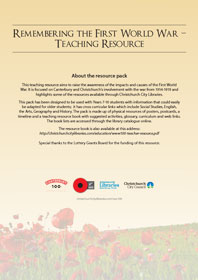
WW1 teaching resource cover letter
[957 KB PDF]

WW1 teaching resource posters
[7.8 MB PDF]
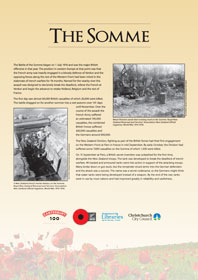
WW1 teaching resource posters
[6.2 MB PDF]
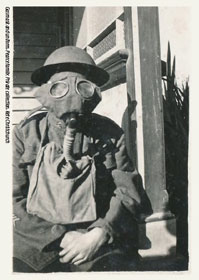
WW1 teaching resource postcards
[3.4 MB PDF]
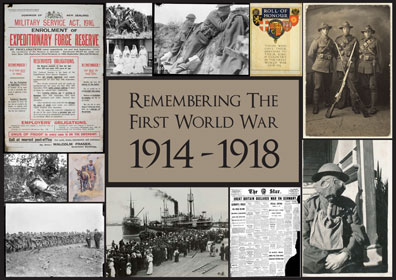
WW1 teaching resource cover
[4.3 MB PDF]
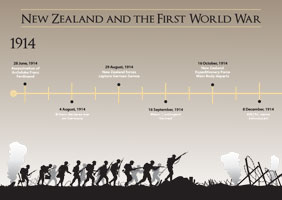
WW1 teaching resource timeline
[2 MB PDF]

WW1 teaching resource bookmark
[472 KB PDF]
Glossary
Alliance
An agreement to work together made between two or more countries.
Allied Powers (Allies)
The nations who fought against the Central Powers. At the start of the war the main Allied Powers were Britain (and its empire), France and Russia.
ANZACs
An acronym used to describe soldiers from Australia and New Zealand. It stands for Australian and New Zealand Army Corps.
Armaments
Weapons and equipment used by a military force.
Armistice
A formal agreement between opposing sides in a war to stop fighting.
Artillery
Large guns, such as cannons, mortars and rockets.
Badge
An emblem (a small piece of cloth or metal) that signifies your status rank or affiliation with an organization or support for a cause.
Barrage
A heavy concentration of artillery fire, sustained for a period of time.
Battalion
A large military unit, often containing between 300 and 1000 soldiers.
Baxter, Archibald
Well-known conscientious objector from Dunedin who was sent to the front line and punished for refusing to fight.
Blockade
Tactic used to prevent food and supplies from getting in or out of a city or port.
Bombardment
A heavy attack or artillery fire.
Canterbury
A province that in 1853 ran from Waitaki to Hurunui Rivers, and from east to west coasts. The region now known as Westland became a separate province in 1873.
Campaign
A military operation
Casualties
A person injured or killed in a war
Cavalry
Soldiers mounted on horseback.
Central Powers
The nations who fought against the Allies. The main Central Powers were Germany, Austria- Hungary and Turkey.
Cenotaph
A monument commemorating people who died in a war.
Civilian
A person who is not a member of the armed forces.
Conscientious Objector
A person who refuses to join the military on the grounds of moral or religious beliefs.
Conscription
Compulsory military service. Conscription was introduced in New Zealand in 1916, as there were not enough men volunteering to join the war.
Dardanelles
A narrow strait of water in northwestern Turkey connecting the Aegean Sea to the Sea of Marmara.
Division
A large military formation consisting of a number of smaller units.
Dog tags
The informal name given to identification tags worn by military personnel.
Dug- outs
Underground shelter used for rest and living space in the trenches.
Eastern Front
The combat zone in Eastern Europe fought over by Russian forces on one side and forces from Germany and Austria- Hungary on the other.
Empire
A group of countries under the control of another country.
Entente
An informal agreement or alliance between two or more countries.
Fatalities
Those killed in action or died of wounds in war.
Flanders
A region in Belgium and the site of the Third Battle of Ypres.
Front Line
Area where part of an army is closest to its enemy and where fighting takes place.
Gallipoli
First battle where New Zealand and Australian (ANZAC) troops supported British and French soldiers in an attempt in 1915 to capture the Gallipoli Peninsula in Turkey
Gangrenous
Rotting skin.
Great War
Another term for the First World War, generally used between the world wars.
Home Front
The term used for civilians that supported the soldiers while away at war.
Infantry
Soldiers that fight on foot
Influenza Epidemic
Influenza (flu) spread through New Zealand between October and December 1918 killing over 8,000 people
Kaiser
The emperor of Germany
League of Nations
A diplomatic organization set up in the aftermath of the First World War.
Lusitania
British passenger ship sunk by a German U- boat in 1915.
Massey, William
Served as New Zealand’s Prime Minister during the First World War
Mobilization
Preparation of a national military force for war
Morale
Confidence or spirits of a person or group
Munitions
Weapons
Neutral
Impartial, does not take sides
No Man’s Land
Term used to describe the dangerous, often battered, and usually narrow ground separating enemy trenches
Occupy
Take control of a place or country by military conquest
Origins
The point or place where something begins
Offensive
A major attack
Owen, Wilfred
British soldier who has become the most well- known poet of the First World War.
Pacifism
A belief that conflict should be settled by peaceful means
Pandemic
Health epidemic of global proportions
Papers Past
Digitised pages from New Zealand newspapers
Passchendaele
Battle on the Western Front in October 1917 with horrific loss of New Zealand lives, part of the Third Battle of Ypres
Propaganda
Information designed to promote or damage a political cause
Rank
Level or position
Reconnaissance
Search for information about enemy positions on either land or sea through observation
Regiment
Unit of the army often divided into companies, squadrons or battalions
Reparations
Post-war payments made by the losers to the winners to pay for wartime damages
Shell Shock
Medical condition caused by the prolonged and distressing experiences of trench warfare
Somme, Battle of
Battle beginning in July 1916 which saw huge casualties on both sides, particularly for the Allies on the first day. New Zealand troops first saw action on the Western Front during this battle.
Sniper
A rifleman or woman who takes shots at enemy soldiers from hidden cover
Tactics
Plan of action or strategy to achieve a specific outcome
Treaty
An agreement between countries
Trench Foot
Rotting disease of the foot caused by prolonged exposure to the cold and dampness of the trenches
Trench Warfare
Type of warfare where two sides fight each other from opposing trenches
Triple Alliance
The military alliance formed in the late 1800s between Germany, Austria- Hungary and Italy. This alliance went on to become Central Powers, but Italy later renounced it and joined the Allied Forces.
Triple Entente
The military alliance between Great Britain, France and Russia.
U-Boat
German submarine
Western Front
Combat zone mainly in northern France and Belgium in which a significant portion of land fighting occurred during the First World War.
